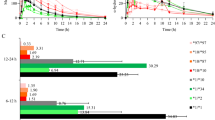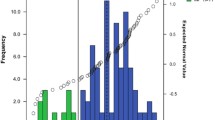Abstract
Metabolism of the antiarrhythmic, propafenone, cosegregates with the sparteine/debrisoquine polymorphism. Patients devoid of CYP2D6 activity have a higher incidence of adverse effects than those with normal enzyme function. In this paper we present a method for rapid assignment of CYP2D6 phenotype using urinary excretion of intact glucuronides of propafenone (PPFG). After establishing an HPLC assay, urinary excretion of PPFG was quantified during one dosage interval and related to individual CYP2D6 activity as determined by phenotyping.
We observed a close correlation of urinary excretion of PPFG with individual CYP2D6 activity (r=0.84, P<0.01) and conclude that this method is suitable for rapid assignment of phenotype during propafenone therapy.
Similar content being viewed by others
References
Siddoway LA, Thompson KA, McAllister BC, Wang T, Wilkinson GR, Roden DM (1987) Polymorphism of propafenone metabolism and disposition in man: clinical and pharmacokinetic consequences. Circulation 75: 785–791
Eichelbaum M, Spannbrucker N, Steincke B, Dengler HJ (1979) Defective N-oxidation of sparteine in man: a new pharmacogenetic effect. Eur J Clin Pharmacol 16: 183–187
Kroemer HK, Mikus G, Kronbach T, Meyer UA, Eichelbaum M (1989) In vitro characterization of the human cytochrome P-450 involved in polymorphic oxidation of propafenone. Clin Pharmacol Ther 45: 28–33
Brosen K, Gram LF, Hagfelt T, Bertilsson L (1987) Extensive metabolizers of debrisoquine become poor metabolizers during quinidine treatment. Pharmacol Toxicol 60: 312–314
Botsch S, Gautier JC, Beaune P, Eichelbaum M, Kroemer HK (1993) Identification and characterization of the cytochrome P450 enzymes involved in N-dealkylation of propafenone: molecular base for interaction potential and variable disposition of active metabolites. Mol Pharmacol 43: 120–126
Funck-Brentano C, Kroemer HK, Lee JT, Roden DM (1990) Propafenone. N Engl J Med 322: 516–525
Rudolph M, Steinhart H (1988) Synthesis of the glucuronide of carazolol. Carbohydr Res 176: 155–159
Latini R, Belloni M, Bernasoni R, Cappiello E, Giani P, Landolina D, Castel LM (1992) Identification of propafenone metaboliser phenotype from plasma and urine excretion data. Eur J Clin Pharmacol 42: 111–114
Kroemer HK, Klotz U (1992) Glucuronidation of drugs. A reevaluation of pharmacological significance of the conjugates and modulating factor. Clin Pharmacokinet 23: 292–310
Kroemer HK, Turgeon J, Thomas T, Roden DM (1989) Accumulation of propafenone glucuronide during chronic oral therapy in man. (abstract) Clin Pharmacol Ther 45: 180
Author information
Authors and Affiliations
Additional information
This work is part of the PhD thesis of S. Botsch at the Department of Pharmaceutical Chemistry, Westfälische-Wilhelms-Universität, Münster, Germany
Rights and permissions
About this article
Cite this article
Botsch, S., Heinkele, G., Meese, C.O. et al. Rapid determination of CYP2D6 phenotype during propafenone therapy by analysing urinary excretion of propafenone glucuronides. Eur J Clin Pharmacol 46, 133–135 (1994). https://doi.org/10.1007/BF00199876
Received:
Accepted:
Issue Date:
DOI: https://doi.org/10.1007/BF00199876




